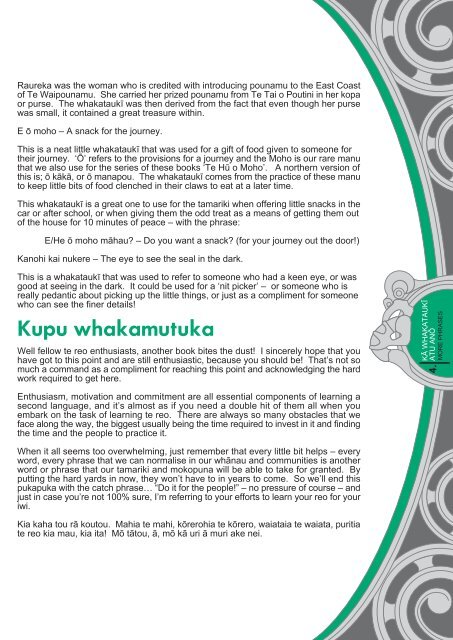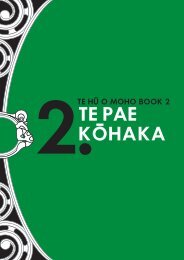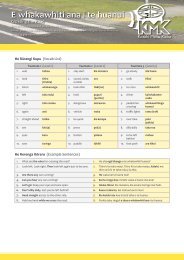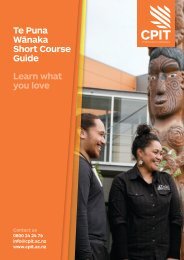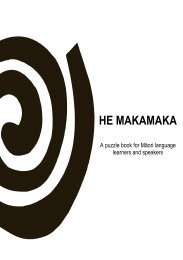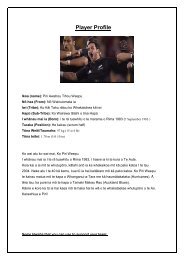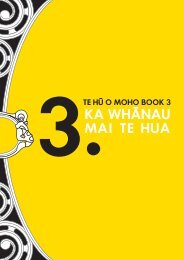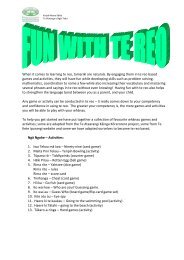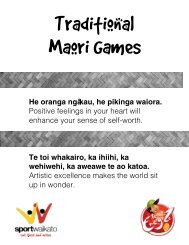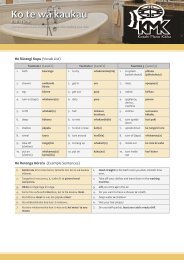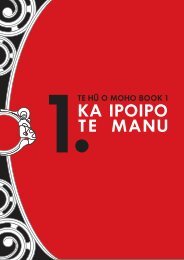Te Hū o Moho Book 4 - Te Pirere - Kotahi Mano Kaika
Te Hū o Moho Book 4 - Te Pirere - Kotahi Mano Kaika
Te Hū o Moho Book 4 - Te Pirere - Kotahi Mano Kaika
You also want an ePaper? Increase the reach of your titles
YUMPU automatically turns print PDFs into web optimized ePapers that Google loves.
Raureka was the woman who is credited with introducing pounamu to the East Coast<br />
of <strong>Te</strong> Waipounamu. She carried her prized pounamu from <strong>Te</strong> Tai o Poutini in her kopa<br />
or purse. The whakataukï was then derived from the fact that even though her purse<br />
was small, it contained a great treasure within.<br />
E ö moho – A snack for the journey.<br />
This is a neat little whakataukï that was used for a gift of food given to someone for<br />
their journey. ‘Ö’ refers to the provisions for a journey and the <strong>Moho</strong> is our rare manu<br />
that we also use for the series of these books ‘<strong>Te</strong> Hü o <strong>Moho</strong>’. A northern version of<br />
this is; ö käkä, or ö manapou. The whakataukï comes from the practice of these manu<br />
to keep little bits of food clenched in their claws to eat at a later time.<br />
This whakataukï is a great one to use for the tamariki when offering little snacks in the<br />
car or after school, or when giving them the odd treat as a means of getting them out<br />
of the house for 10 minutes of peace – with the phrase:<br />
E/He ö moho mähau? – Do you want a snack? (for your journey out the door!)<br />
Kanohi kai nukere – The eye to see the seal in the dark.<br />
This is a whakataukï that was used to refer to someone who had a keen eye, or was<br />
good at seeing in the dark. It could be used for a ‘nit picker’ – or someone who is<br />
really pedantic about picking up the little things, or just as a compliment for someone<br />
who can see the finer details!<br />
Kupu whakamutuka<br />
Well fellow te reo enthusiasts, another book bites the dust! I sincerely hope that you<br />
have got to this point and are still enthusiastic, because you should be! That’s not so<br />
much a command as a compliment for reaching this point and acknowledging the hard<br />
work required to get here.<br />
KÄ WHAKATAUKÏ<br />
ATU ANÖ<br />
MORE PHRASES<br />
4.<br />
Enthusiasm, motivation and commitment are all essential components of learning a<br />
second language, and it’s almost as if you need a double hit of them all when you<br />
embark on the task of learning te reo. There are always so many obstacles that we<br />
face along the way, the biggest usually being the time required to invest in it and finding<br />
the time and the people to practice it.<br />
When it all seems too overwhelming, just remember that every little bit helps – every<br />
word, every phrase that we can normalise in our whänau and communities is another<br />
word or phrase that our tamariki and mokopuna will be able to take for granted. By<br />
putting the hard yards in now, they won’t have to in years to come. So we’ll end this<br />
pukapuka with the catch phrase… “Do it for the people!” – no pressure of course – and<br />
just in case you’re not 100% sure, I’m referring to your efforts to learn your reo for your<br />
iwi.<br />
Kia kaha tou rä koutou. Mahia te mahi, körerohia te körero, waiataia te waiata, puritia<br />
te reo kia mau, kia ita! Mö tätou, ä, mö kä uri ä muri ake nei.


